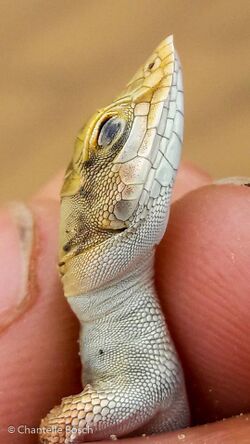Biology:Shovel-snouted lizard
| Shovel-snouted lizard | |
|---|---|

| |
| Scientific classification | |
| Domain: | Eukaryota |
| Kingdom: | Animalia |
| Phylum: | Chordata |
| Class: | Reptilia |
| Order: | Squamata |
| Family: | Lacertidae |
| Genus: | Meroles |
| Species: | M. anchietae
|
| Binomial name | |
| Meroles anchietae (Bocage, 1867)
| |
| Synonyms[2][3] | |
| |
The shovel-snouted lizard (Meroles anchietae), also known commonly as Anchieta's desert lizard, Anchieta's dune lizard and the Namib sand-diver, is a species of lizard in the family Lacertidae. The species is native to southern Africa.
Etymology
The specific name, anchietae, is in honor of Portuguese naturalist José Alberto de Oliveira Anchieta, who was an explorer of Africa.[4]
Geographic range
M. anchietae is found in Angola and Namibia.[2]
Habitat
The preferred natural habitat of M. anchietae is desert, with aeolian sand dunes and sparse vegetation, at altitudes from sea level to 500 m (1,600 ft).[1]
Description
Adults of M. anchietae have a snout-to-vent length (SVL) of about 5 cm (2.0 in). [5]
Diet
M. anchietae preys upon insects, especially small beetles. During dry periods when insects are scarce, it will eat seeds.[5]
Reproduction
References
- ↑ 1.0 1.1 Baptista N, Bauer AM, Becker F, Conradie W (2020). "Meroles anchietae ". The IUCN Red List of Threatened Species 2020: e.T196981A110221608. https://dx.doi.org/10.2305/IUCN.UK.2020-3.RLTS.T196981A110221608.en. Downloaded on 12 April 2020.
- ↑ 2.0 2.1 2.2 Meroles anchietae at the Reptarium.cz Reptile Database. Accessed 5 May 2019.
- ↑ Boulenger GA (1887). Catalogue of the Lizards in the British Museum (Natural History). Second Edition. Volume III. Lacertidæ ... London: Trustees of the British Museum (Natural History). (Taylor and Francis, printers). xii + 575 pp. + Plates I–XL. (Aporosaura anchietæ, new combination, p. 117).
- ↑ Beolens B, Watkins M, Grayson M (2011). The Eponym Dictionary of Reptiles. Baltimore: Johns Hopkins University Press. xiii + 296 pp. ISBN:978-1-4214-0135-5. (Meroles anchietae, p. 8).
- ↑ 5.0 5.1 Branch, Bill (2004). Field Guide to Snakes and other Reptiles of Southern Africa. Third Revised edition, Second impression. Sanibel Island, Florida: Ralph Curtis Books. 399 pp. ISBN:0-88359-042-5. (Meroles anchietae, pp. 164–165 + Plate 56).
Further reading
- Arnold EN (1989). "Towards a phylogeny and biogeography of the Lacertidae: relationships within an Old-World family of lizards derived from morphology". Bulletin of the British Museum (Natural History), Zoology 55 (2): 209–257. (Meroles anchietae, new combination).
- Bocage JVB (1867). "Descriptions of two new Saurians from Mossamedes (West Africa)". Annals and Magazine of Natural History, Third Series 20: 225–228. (Pachyrhynchus anchietæ, new species, pp. 227–228, Figures 1–2).
- Loveridge A (1936). "African Reptiles and Amphibians in the Field Museum of Natural History". Zoological Series, Field Museum of Natural History 22 (1): 1–122. (Aporosaura anchietae, p. 63).
Wikidata ☰ Q5079132 entry
 |


